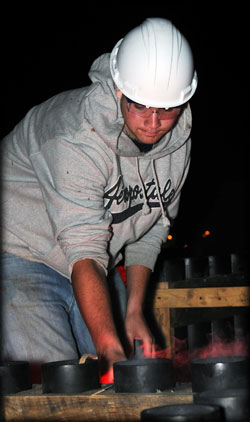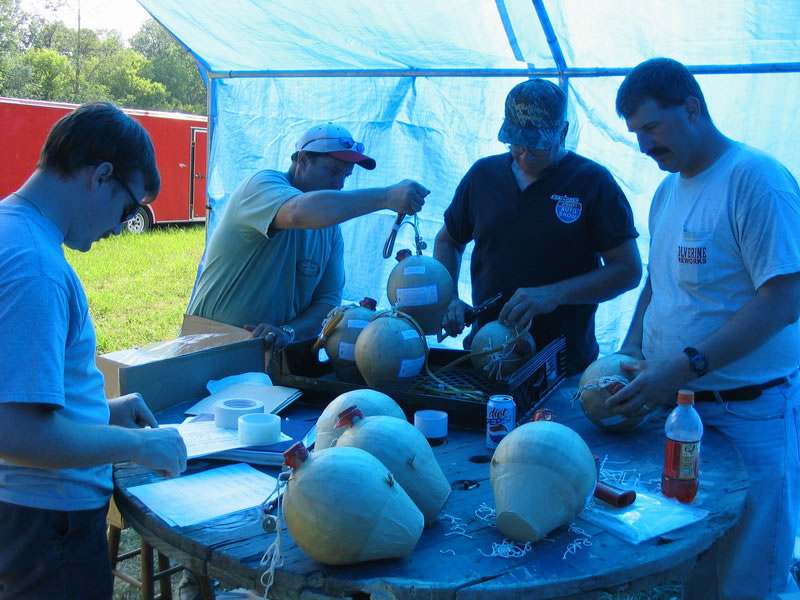Ecucation of an Pyrotechnists:
1. The display company orders the fireworks from the manufacturer - This is done long before the show is booked. The majority of the fireworks you see are shipped from overseas. It's much more cost effective to order them from overseas. Besides, most of the "product" received from overseas is of excellent quality.
2. The customer decides they want a fireworks display - They then call the display company and discuss their options. These options include show size, show duration, exact show location, show cost, show logistics, and any special requests such as music correography.
3. Licensed pyrotechnic operator contracted and show scripted - A licensed operator is contacted and agrees to setup and shoot the said display. A Show Producer who works for the display company will now compose a unique script which the show will follow.
4. The licensed operator meets with customer and fire inspector at display site - During this meeting, site safety, music coordination, and other logistical matters are taken care of.
5. The licensed operator and his crew set up the show - Depending on the show size, this can take a few hours to a few days. The operator will pick the show up (already packed in a truck) from the display company, then drive it out to the display site. The operators crew will meet him/her at the display site at a pre-designated time for setup.
6. The display is fired - The display goes off and then the crew re-packs the equipment into the truck. The operator then has the responsibility of returning the truck and equipment to the display company along with finishing/submitting all required paperwork.
7. Customer and his audience are happy - Process then has the potential to repeat again next year.

Step 1 - Originally, the simplest possible form was tried, just the number of shells divided by the number of crew to give a "shot per person" type of answer. When plotted alongside the time it took to setup an actual show, the graph was not accurate, nor consistent, therefore useless. So it was fairly obvious that there were some other factors that needed to be added to the equation.
Step 2 - Knowing that each crew member had his/her own working pace, and that experience and work ethic played a big role in the length of time needed to set a show up with a given crew, a "Quality" factor was added to each crew member. The quality factor added to the accuracy of the equation slightly, but the equation was still not consistent with it's prediction where large crews were used.
Step 3 - I have had all different sized crews before, and made a key observation when the crew reached a really large size. There came a point where there was not enough work for everyone, and alot of people found themselves standing around a good portion of the time. Therefore, a logarithmic dependence on the number of crew was used in the equation. The logarithm implies that the efficiency of adding more crew starts to decrease at a certain threshold.
Step 4 - The equation was now becoming fairly consistent for certain types of shows. When shows that utilized sand boxes, set pieces, or were setup on a barge were used in the equation, the equation became inconsistent again. Since these type of shows add additional time per shot, a factor was added to accomidate for this. This solved the problem. The equation now became consistent and was able to accurately predict setup times.
|
Right: Big guns. Notice these 10" and 12" guns are in thier own sand filled barrels. Also notice that they are steel, while all the other tubes are HDPE.
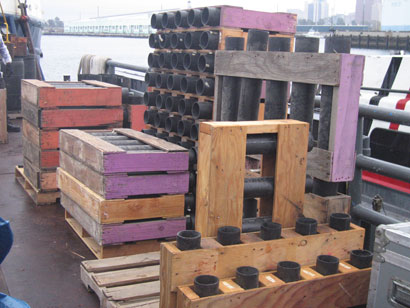 |
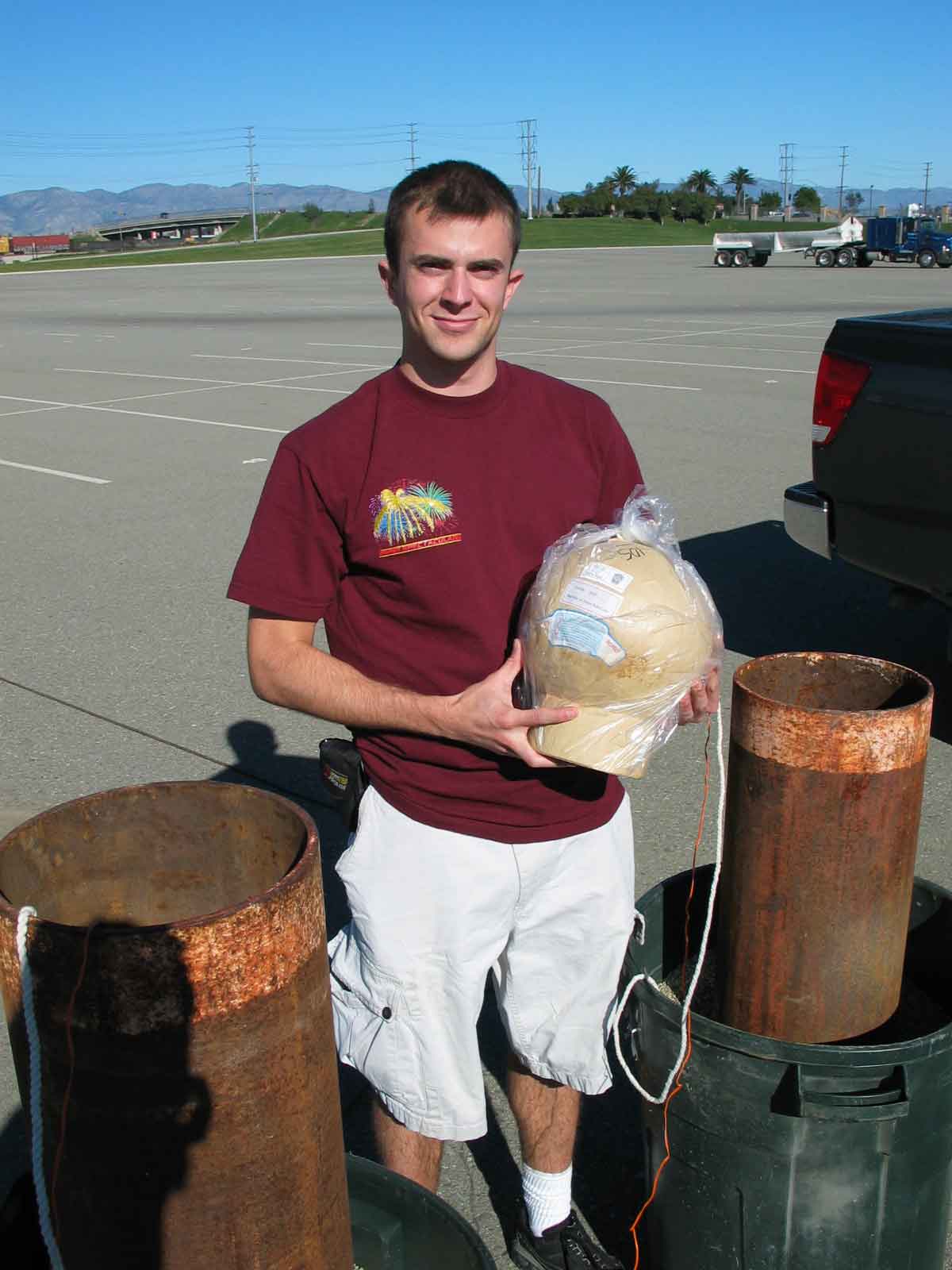 |
 |
|
Unloading:
There is not too much to unloading the truck. The only thing that should be said here, is that you should generally leave your product on the truck out of the way until your ready to load it in the guns. Get all your equipment down, set it up, then remove the goodies. Of course there are exceptions to every rule. One example would be in the case of a rooftop show where all equipment and product needs to get hoisted up to the roof in one sitting. |
| What is a fireworks rack?
A fireworks rack, contains a given number of aerial mortar tubes (aka "guns") of a given size. The racks are constructed from wood. The mortars a typically constructed out of three materials, namely HDPE (High Density PolyEthylene), paper, or steel. HDPE becoming the most common. Racks can only contain paper or HDPE tubes. Steel tubes must be buried 2/3 of thier length. HDPE is used instead of say PVC or ABS due to its special energy absorbtion properties. The energy from a tube detonation goes into expanding and splitting the HDPE material, in contrast to PVC which would splinter and fragment throwing shrapnel and therfore be unsafe to use unburried in a rack. The number of tubes per rack depends on the size (diameter) of the gun. Each rack has only one size of tube. Here is a general rule of thumb for mortar racks: Less than 3" diameter, 5 tubes per rack 3" or 4", 5 tubes per rack 5", 6", 8", 3 tubes per rack 10" or larger get put in individual barrels of sand |
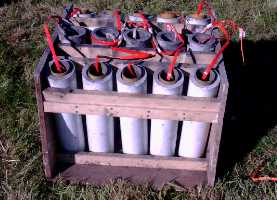 |
What is a mortar box?

A mortar box is exactly what the name states. A box your going to fill with mortars. Each box, consists of two long sides and two short sides, which form a frame with no top or bottom when assembled. These wooden frames are assembled using metal rods, washers, and cotter pins, then filled with sand. These boxes are usually only used on the 4th when there are simply not enough racks to go around. Sand boxes take much longer to fill than it takes to kleet an equivalent number of racks. Mortar boxes are required if you are shooting out of steel tubes. By law, the steel tubes must be burried 2/3 of thier length in the sand in case of a tube fragmentation.
How do you assemble a mortar box?
Very simply actually. Take the two small sides, or ends, and slide them in place between the two long sides. There are six holes for the rods which hold the boxes together. Insert rod through both sides, put washers on both sides of the rod on the outside of the box, and secure using the cotter pins.
How to shoot?
 |
Normaly take old school Handfiring, the computerized Firing Systems bring new and exciting possibilities into modern fireworks displays. With added capabilities comes added complexity. Throughout this tutorial, we try to make understanding of the computerized firing system as painless as possible. Although most of the topics discussed are general and would apply to most computerized firing systems, we shall focus mainly on the Pyrodigital (aka PD) firing system. The Pyrodigital firing system is one of the most versital and reliable computerized firing systems out there. My topics will only give you a glimpse at all the features of the PD system. Included are basic operation as well as advanced concepts for all levels of understanding. It is reccommended that you go through the "Basic Theory of Operation" before continuing to the other topics. |
How do you program when each shot will fire?
This is done through software on a PC long before you start your setup in the field. A show producer will script the show ahead of time, and download it to the FC. Technically, you could program each shot one at a time into the controller by using the keypad on the FC, but this is not really practical for a typical size show due to the amount of time it would take. The keypad and editing functions on the FC are used mainly for making slight modifications to a script such as changing a shot address, shot time, or inserting new shots if neccessary.
How is Pyrodigital's time formated?
The Pyrodigital system uses hours, minutes, seconds, and frames (00:00:00:00). Hours, minutes, and seconds are self explainitory. There are 30 frames per second (this is standard for video). In other words, each second is divided into 30 segments. So in a script, a particular shot time might be 00:03:21:17, which means that shot will fire at 0 hours, 3 minutes, 21 seconds, and 17 frames on the show clock.
Misfire!
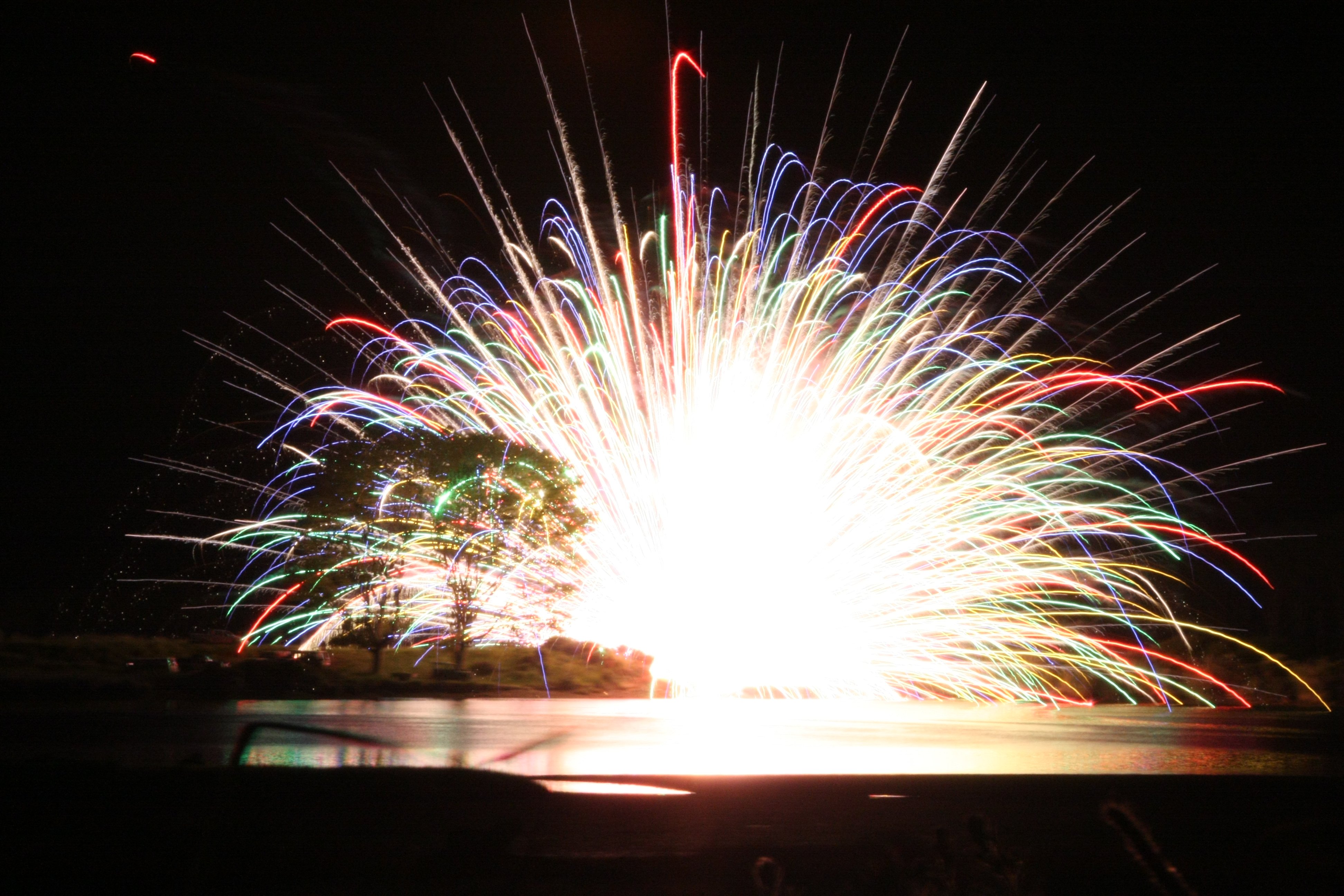
A misfire occures when fire has been presented to a device, and the device failed to function entirely, not ever leaving the tube. Now keep in mind, if you hit a cue, and the electric match is bad and does not function, that in legal terms, is not a misfire since fire was never presented to the device.
What do I do with a misfire?
This ultimately depends what type of mis-fire it was. A true mis-fire, where the quickmatch has ignited and made it's way down the gun but failed to ignite the lift charge must have the mortar filled with water to extinguish any possible burning embers lingering around. This according to the law must be done when ever fire has taken to the device and the device failed to leave the tube. This could include a shell within a finale chain which had the quickmatch lead blow apart during firing, thus leaving a shell or two behind. These are most dangerous since fire was present, and could have (and does in most cases) left the paper of the quickmatch smoldering. For this reason, I check my finale racks last when checking for misfires.
Holiday fireworks accidents kill 5

OCRACOKE, N.C. (AP) -- Five people working on Independence Day fireworks shows were killed by explosions, four of them by a single blast that rocked this remote village on the Outer Banks.
The fifth died after an explosion at a fireworks show in Pennsylvania, police said. "It was like 40 minutes worth of fireworks going off in four seconds," Raborn said.
In another holiday accident, a pedestrian bridge collapsed in Indiana as fans were leaving a fireworks show, injuring 25 people. Authorities said Sunday the crowd had overloaded the bridge.
The blast at Ocracoke came as workers were unloading fireworks Saturday from a truck at the Anchorage Marina, shaking homes and businesses across the southern end of Ocracoke Island and rattling residents and tourists.
Earl Woodham, a spokesman for the Bureau of Alcohol, Tobacco, Firearms and Explosives, said agents determined the cause was accidental. ATF will not investigate further, but a workplace safety agency such as the state Labor Department likely will try to find the specific cause, he said.
Dock master Robert Raborn was about 200 yards away from the truck and said the explosion was one of the loudest things he had ever heard.
